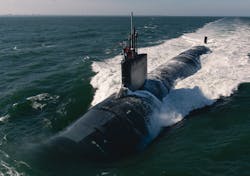Electric Boat prepares to build two more Virginia-class attack submarines, sensors, and signal processing
WASHINGTON – U.S. Navy undersea warfare experts are preparing to build two new Virginia-class fast-attack submarines under terms of a $216.5 million contract announced Friday.
Officials of the Naval Sea Systems Command in Washington are asking General Dynamics Electric Boat in Groton, Conn., to obtain long-lead materials for two yet-unnamed Virginia-class fast-attack submarines, SSN 814 and SSN 815.
Long-lead items either are difficult and time-consuming to obtain, and are funded early in the aircraft design process to keep overall production on schedule. Contracts to build the submarines will come later.
These two attack submarines will be the 40th and 41st Virginia-class boats in the Navy's fleet of undersea warfare systems. The Navy has commissioned or launched 24 Virginia-class submarines. The others either are under construction or authorized for building. The latest Virginia-class boat to be launched, USS Iowa (SSN 797) was launched last June.
Some of these undersea vessels will have the Virginia Payload Module, a mid-body section on the centerline of the submarine that contains four additional Virginia Payload Tubes that replace single-purpose cruise missile launch tubes.
The VPM increases the overall length of the submarine, and enables the Virginia-class submarine to carry as many as 28 additional Tomahawk cruise missiles, similar munitions, or unmanned underwater vehicles (UUVs). Each of the four VPM tubes can fit as many as seven Tomahawk missiles.
Compared to their predecessors such as the U.S. Seawolf- and Los Angeles-class attack submarines, the Virginia class offers several electronic, electro-optical, and propulsion innovations not previously built into other submarine classes.
The Virginia class, for the first time, has no opening in its pressure hull through which a conventional periscope raises and lowers. Instead, the nation's newest submarine class have photonics masts with high-resolution daylight cameras, light-intensification and infrared sensors, an infrared laser rangefinder, and special electronics to intercept enemy communications.
Instead of passing through an opening in the boat's pressure hull, which can create a weak spot in combat, signals from photonics mast sensors enter the submarine via optical fiber for signal processing in the boat's command center.
In addition, the Virginia class also has improved sonar systems and electromagnetic signature reduction to reduce the possibility of enemy detection. The boat has a bow-mounted spherical active and passive sonar array, a wide aperture lightweight fiber optic sonar array, and two high-frequency active sonars in the sail and keel.
The Virginia class also has low-frequency and high-frequency towed sonar arrays, a chin-mounted high-frequency sonar to supplement the boat's main sonar array for operations in coastal waters and to detect enemy submarines.
Instead of traditional bladed propellers, the Virginia class has pump-jet propulsors to reduce the risks of cavitation and enable quieter operation than traditional propellers allow. The boat also has fiber-optic fly-by-wire ship control, AN/BYG-1 combat system, and nine-man lockout chamber for covert insertion of Special Operations forces.
Virginia-class submarines are designed for anti-submarine and surface ship warfare and special operations support, as well as intelligence, surveillance, and reconnaissance (ISR). They are to replace legacy Los Angeles-class attack submarines as the older boats are retired. Los Angeles-class subs have been at sea since the 1970s.
Without the Virginia Payload Module, Virginia-class submarines displace 7,800 tons, are 377 feet long, and 34 feet in diameter. They can travel faster than 25 knots and dive deeper than 800 feet. They carry Mark 48 advanced capability torpedoes, Tomahawk land-attack missiles, and unmanned underwater vehicles (UUVs).
On this contract Electric Boat will do the work in Minneapolis; Spring Grove, Ill; York and Bethleham Pa.; Florence, N.J.; Windsor Locks, Conn; Warren, Mass.; Salem, Ohio; South El Monte, Calif.; Tacoma, Wash; and other locations, and should be finished by September 2034.
For more information contact General Dynamics Electric Boat online at www.gdeb.com, or Naval Sea Systems Command at www.navsea.navy.mil.
About the Author
John Keller
Editor-in-Chief
John Keller is the Editor-in-Chief, Military & Aerospace Electronics Magazine--provides extensive coverage and analysis of enabling electronics and optoelectronic technologies in military, space and commercial aviation applications. John has been a member of the Military & Aerospace Electronics staff since 1989 and chief editor since 1995.
